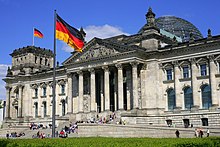The flag of Germany story
The flag of Germany story
The flag of Germany is a tricolour consisting of three equal horizontal bands displaying the national colours of Germany: black, red, and gold. The flag was first adopted as the national flag of modern Germany in 1919, during the Weimar Republic.
The black-red-gold tricolour first appeared in the early 19th century and achieved prominence during the 1848 Revolutions. The short-lived Frankfurt Parliament of 1848–1850 proposed the tricolour as a flag for a united and democratic German state. With the formation of the Weimar Republic after World War I, the tricolour was adopted as the national flag of Germany. Following World War II, the tricolour was designated as the flag of both West and East Germany in 1949. The two flags were identical until 1959, when the East German flag was augmented with the coat of arms of East Germany. Since reunification on 3 October 1990, the black-red-gold tricolour has become the flag of reunified Germany.
The flag of Germany has not always used black, red, and gold as its colours. After the Austro-Prussian War in 1866, the Prussian-dominated North German Confederation adopted a tricolour of black-white-red as its flag. This flag later became the flag of the German Empire, formed following the unification of Germany in 1871, and was used until 1918. Black, white, and red were reintroduced as the German national colours with the establishment of Nazi Germany in 1933, replacing German republican colours with imperial colours until the end of World War II.
The colour schemes of black-red-gold and black-white-red have played an important role in the history of Germany and have had various meanings. The colours of the modern flag are associated with the republican democracy formed after World War I, and represent German unity and freedom: not only the freedom of Germany, but also the personal freedom of the German people. During the Weimar Republic, the black-red-gold colours were the colours of the democratic, centrist, and republican political parties, as opposed to the political right and political left, as seen in the name of Reichsbanner Schwarz-Rot-Gold, formed by members of the SPD, the German Centre Party, and the German Democratic Party to defend the republic against extremists on the right and left, to teach the population to respect the new republic, and to honour its flag and the constitution.
The German association with the colours black, red, and gold surfaced in the radical 1840s, when the black-red-gold flag was used to symbolize the movement against the Conservative European Order that was established after Napoleon's defeat.
The Frankfurt Parliament had declared the black-red-gold as the official colours of the German Confederation, with the red in the tricolour most likely referencing the Hanseatic League, and the gold and black symbolizing Austria as its empire, considered to be "German", had an influence over (what would become) southern Germany. There are many theories in circulation regarding the origins of the colour scheme used in the 1848 flag. It has been proposed that the colours were those of the Jena Student's League, one of the radically minded Burschenschaften banned by Metternich in the Carlsbad Decrees. Another claim goes back to the uniforms (mainly black with red facings and gold buttons) of the Lützow Free Corps, comprising mostly university students and formed during the struggle against the occupying forces of Napoleon. It is during the mid-nineteenth century that red became synonymous with revolution and Karl Marx's socialist vision. Whatever the true explanation, these colours soon came to be regarded as the national colours of Germany during this brief period, and especially after their reintroduction during the Weimar period, they have become synonymous with liberalism in general.
Civil flag
The German national flag or Bundesflagge (federal flag), containing only the black-red-gold tricolour, was introduced as part of the (West) German constitution in 1949.[Following the creation of separate government and military flags in later years, the plain tricolour is now used as the German civil flag and civil ensign. This flag is also used by non-federal authorities to show their connection to the federal government, e.g. the authorities of the German states use the German national flag together with their own flag.Government flag

معلومات حول الموضوع
 العنوان : The flag of Germany story
العنوان : The flag of Germany storyالوصف : The flag of Germany story The flag of Germany story The flag of Germany is a tricolour consisting of three equal horizontal bands disp...
تقييم الموضوع : 4.5
الكاتب : غير معرف





0 التعليقات:
إرسال تعليق